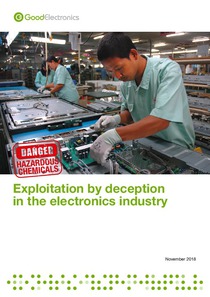Exploitation by deception in the electronics industry
"Tens of millions of workers are exposed to hazardous substances in the workplace every day. According to the International Labour Organization (ILO), approximately four workers die every minute as the result of working in an unsafe or unhealthy workplace. The electronics industry is no excepti...
| Main Authors: | , , |
|---|---|
| Institution: | ETUI-European Trade Union Institute |
| Format: | TEXT |
| Language: | English |
| Published: |
Amsterdam
2018
GoodElectronics |
| Subjects: | |
| Online Access: | https://www.labourline.org/KENTIKA-19307068124911252409-exploitation-by-deception-in-t.htm |
| Summary: | "Tens of millions of workers are exposed to hazardous substances in the workplace every day. According to the International Labour Organization (ILO), approximately four workers die every minute as the result of working in an unsafe or unhealthy workplace. The electronics industry is no exception as it uses toxic substances throughout its lifecycle. Cases from around the world have brought to light the extent to which electronics workers are exposed to toxic chemicals at work. These cases have implicated governments and companies in the world’s richest and poorest countries along the lifecycle of electronic goods – from the extraction of raw materials to the manufacture of electronic components and products, to recycling and recovery operations.
A common denominator across many of these cases of workers’ exposure to hazardous substances is the lack or inadequacy of information. In the context of the large volumes of hazardous substances used by workers in various industries, providing adequate information is essential to help prevent risks, mitigate harms, conduct research on safer alternatives, and to provide an effective remedy. In these circumstances, information is fundamental to the enjoyment of human rights – in essence a right unto itself and an enabler of other human rights. ..." |
|---|---|
| Physical Description: | 21 p. Digital |

